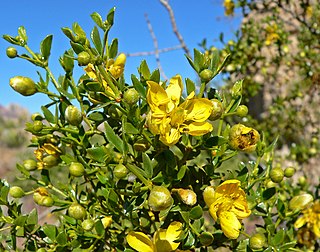
Zygophyllaceae is a family of flowering plants that contains the bean-caper and caltrop. The family includes around 285 species in 22 genera.

Fagonia is a genus of wild, flowering plants in the caltrop family, Zygophyllaceae, having about 35 species. Species occurring in the US are commonly referred to as fagonbushes. The distribution of the genus includes parts of Africa, the Mediterranean Basin, the Mid-East, India, and parts of the Americas. Fagonia species have been used ethnobotanically by traditional practitioners under Ayurvedic and other healing regimes for many maladies. Species occur in deserts, dry washes, ditches and on rocky outcrops, including at altitude.

Melhania is a genus of small shrubs or herbaceous plants. Traditionally included in the family Sterculiaceae, it is included in the expanded Malvaceae in the APG and most subsequent systematics. The genus is named for Mount Melhan in Yemen.
Bullockia is a genus of flowering plants in the family Rubiaceae. It was originally described as a subgenus of Canthium. The genus is distributed in eastern and southern Africa from Ethiopia to Transvaal, as well as Madagascar in bushland, woodland, savannas, and dry, deciduous forests.
Tetraena giessii, synonym Zygophyllum giessii, is a species of plant in the family Zygophyllaceae. It is endemic to Namibia. Its natural habitats are rocky areas and cold desert. It is threatened by habitat loss.

Zygophyllum is the type genus of the flowering plant family Zygophyllaceae. The generic name is derived from the Greek words ζυγόν (zygon), meaning "double", and φυλλον (phyllon), meaning "leaf". It refers to the leaves, each of which have two leaflets. The genus is distributed in arid and semi-arid regions of Africa, the Mediterranean Basin, central Asia and Australia.
Roepera similis is a succulent annual herb native to Australia.
Bremeria is a genus of flowering plants in the family Rubiaceae. It was described in 2005 to accommodate all the Indian Ocean species formerly placed in Mussaenda, except the widespread Mussaenda arcuata. The genus is indigenous to Madagascar, Mauritius and Réunion, and is found in humid to subhumid evergreen forests.

Rubioideae Juss., 1789 is a subfamily of flowering plants in the family Rubiaceae and contains about 7600 species in 27 tribes.

Tetraena alba is a species of plant in the family Zygophyllaceae which is found in arid regions of Africa and the Arabian Peninsula. It is a salt tolerant plant and dominates many of the plant communities in which it grows.

Tetraena fontanesii, synonym Zygophyllum fontanesii, is a species of plant of the family Zygophyllaceae. It is found in Macaronesia and northwest Africa.

Gynochthodes is a genus of flowering plants in the family Rubiaceae. The genus is found from Madagascar to tropical and subtropical Asia and the Pacific region.

Tetraena is a genus of flowering plants in the family Zygophyllaceae.

Roepera is a genus of flowering plant in the family Zygophyllaceae. It is native to southern Africa and Australia.

Tetraena simplex, commonly known as hureim or simple-leaved bean caper, is a halophytic flowering plant that is distributed in arid regions of the Western Asia and Africa. It is an annual and has a history of being used in Arabic folk medicine as an anti-inflammatory.

Crabbea is a genus of flowering plants native to eastern and southern Africa. They are generally low-growing perennial herbs. The five-petaled flowers are surrounded by prickly bracts.
Tribulocarpus is a genus of flowering plants belonging to the family Aizoaceae.
Afroqueta is a genus of flowering plants belonging to the family Passifloraceae.
Arboa is a genus of flowering plants belonging to the family Passifloraceae.










